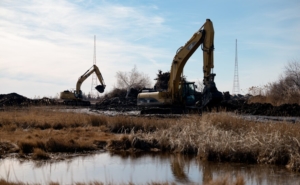Editor’s Note: This article was written by Patrick Skahill, Connecticut Public Radio reporter at WNPR on March 29, 2022. The Stratford Crier finds this article relevant as it pertains to our Great Meadows Marsh restoration project in Stratford, and would be in play should Sikorsky Airport expand.

Workers in excavators dig up fill as they regrade the land in the Great Meadows Marsh restoration project in Stratford. Decades ago, when Stratford was being developed, fill was dumped into the marsh. Now the area is undergoing a large-scale restoration to combat sea level rise. (Ryan Caron King/ Connecticut Public)
Plunked on a southern New England shoreline is an understated and misunderstood ecosystem: Great Meadows Marsh in Stratford. For decades, that site was treated as an ugly nuisance, but it’s the focus of a $4 million restoration project aiming to make the coast more resilient to climate change.
Rick Potvin, Manager of the Stewart B. McKinney National Wildlife Refuge in Stratford, said he understands that salt marshes often don’t look like much.
“When you take a look at the marsh, I think people see: Well, you know, that’s someone’s lawn that hasn’t been kept up,” Potvin said. “But what [they] don’t understand is all of the intricacies within the marsh.”
Despite their looks, Potvin said, salt marshes are biological powerhouses. They provide unique habitat for wildlife and are a key barrier against climate change.
“Let’s think about if I own a house over here. And the hurricane comes. And the hurricane brings the entire storm surge, and it comes rushing in,” Potvin said. “Well, where’s that water going to go here? It’s gonna hit this marsh, the marsh is going to absorb the power, dissipate the water, and I don’t have water in my basement. That makes me happy.”
But for decades, Jim Turek, a restoration ecologist with the National Oceanic and Atmospheric Administration, said Great Meadows Marsh was considered to be pretty useless.
“A lot of the marsh and the swamp in this area was considered a nuisance. Mosquito-producing. You couldn’t use it for agriculture. You couldn’t build a home on it,” Turek said.
So developers basically treated salt marshes as coastal dumps. Here at Great Meadows, Turek said, “They took dredged sediments from Bridgeport Harbor. It was right after World War II, and this is where they deposited it.”
Turek bent down and picked up some of that sediment.
“This used to be at the bottom of Bridgeport Harbor. And it’s clean. It’s not contaminated. It’s actually very good soil,” he said.
An Amazon fulfillment center sits on the edge of the Great Meadows Marsh, where many rare and vulnerable bird species take refuge. The marsh, which is part of the Stewart B. McKinney National Wildlife Refuge, is undergoing a restoration project to increase its resiliency and health. Marshes act as natural buffers during storms and often naturally move as sea level rises. But many marshes in Connecticut have been trapped in by development along the coastline. (Ryan Caron King/ Connecticut Public)

Restoring tidal flow
The Connecticut Department of Energy and Environmental Protection estimates over one-third of the state’s tidal wetlands have been lost due to dredging, drainage or fill operations.
All that created a problem at Great Meadows. Water wasn’t moving here like it should. On a recent visit, teams of laborers drove dump trucks and excavators, working to restore the marsh, in part by digging up and redistributing some of that old dredged soil.
When the soil work is done, thousands of plants will be brought into the marsh and planted.
Suzanne Paton, a biologist with the U.S. Fish and Wildlife Service, gestured to excavators working in the distance to create creeks that ebb and flow more naturally with the tides.
“We don’t want any berms or anything that would impound water,” Paton said. “For the plants to be healthy, the water needs to drain off when the tide goes out.”
Paton said salt marsh restoration projects like this are underway throughout the Northeast. In New England, a spokesperson for the USFWS said projects are underway in Massachusetts and Maine.
Paton said these projects could also benefit a coastal bird that relies on northeastern salt marshes to reproduce but has been threatened by sea level rise: the saltmarsh sparrow.
Corrie Folsom-O’Keefe, with Audubon Connecticut, said that each year saltmarsh sparrows come to habitats like these to build nests and raise their babies. They do it all in a matter of weeks.
“Because of sea level rise, that period of time that it has to do its whole breeding cycle is shrinking,” Folsom-O’Keefe said.
To give the birds more of a chance, workers are building large dirt mounds, which they hope will keep nests up out of the rising seawaters in the decades to come.
Because, the team agreed, it’s the duty of land managers today to ensure that salt marshes are ready for the unpredictable challenges posed by rising water levels or extreme weather tomorrow.
“You think about all the things these marshes provide for us,” Potvin said. “What we have to do as land managers is get these habitats as robust as we can so we can so we can support these animals as we go through climate change.”


Thank you for the information about such necessary work.